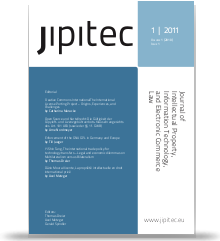Software als Schutzgegenstand des Europäischen Urheberrechts
Keywords:
Algorithmen, Benutzeroberfläche, Computerprogramm, Individualität, Originalität, Programmcode, Programmiersprachen, Programmstruktur, Richtlinie 2001/29, Richtlinie 2009/24, Richtlinie 91/250, Schnittstelle, Software, Steuerungsfunktion, Werkbegriff, öffentliche WiedergabeAbstract
After 20 years of silence, two recent references from the Czech Republic (Bezpečnostní softwarová asociace, Case C-393/09) and from the English High Court (SAS Institute, Case C-406/10) touch upon several questions that are fundamental for the extent of copyright protection for software under the Computer Program Directive 91/25 (now 2009/24) and the Information Society Directive 2001/29. In Case C-393/09, the European Court of Justice held that “the object of the protection conferred by that directive is the expression in any form of a computer program which permits reproduction in different computer languages, such as the source code and the object code.” As “any form of expression of a computer program must be protected from the moment when its reproduction would engender the reproduction of the computer program itself, thus enabling the computer to perform its task,” a graphical user interface (GUI) is not protected under the Computer Program Directive, as it does “not enable the reproduction of that computer program, but merely constitutes one element of that program by means of which users make use of the features of that program.” While the definition of computer program and the exclusion of GUIs mirror earlier jurisprudence in the Member States and therefore do not come as a surprise, the main significance of Case C-393/09 lies in its interpretation of the Information Society Directive. In confirming that a GUI “can, as a work, be protected by copyright if it is its author’s own intellectual creation,” the ECJ continues the Europeanization of the definition of “work” which began in Infopaq (Case C-5/08). Moreover, the Court elaborated this concept further by excluding expressions from copyright protection which are dictated by their technical function. Even more importantly, the ECJ held that a television broadcasting of a GUI does not constitute a communication to the public, as the individuals cannot have access to the “essential element characterising the interface,” i.e., the interaction with the user. The exclusion of elements dictated by technical functions from copyright protection and the interpretation of the right of communication to the public with reference to the “essential element characterising” the work may be seen as welcome limitations of copyright protection in the interest of a free public domain which were not yet apparent in Infopaq. While Case C-393/09 has given a first definition of the computer program, the pending reference in Case C-406/10 is likely to clarify the scope of protection against nonliteral copying, namely in how far the protection extends beyond the text of the source code to the design of a computer program and where the limits of protection lie as regards the functionality of a program and mere “principles and ideas.” In light of the travaux préparatoires, it is submitted that the ECJ is also likely to grant protection for the design of a computer program, while excluding both the functionality and underlying principles and ideas from protection under the European copyright directives.Downloads
Published
2011-07-26
Issue
Section
Artikel

